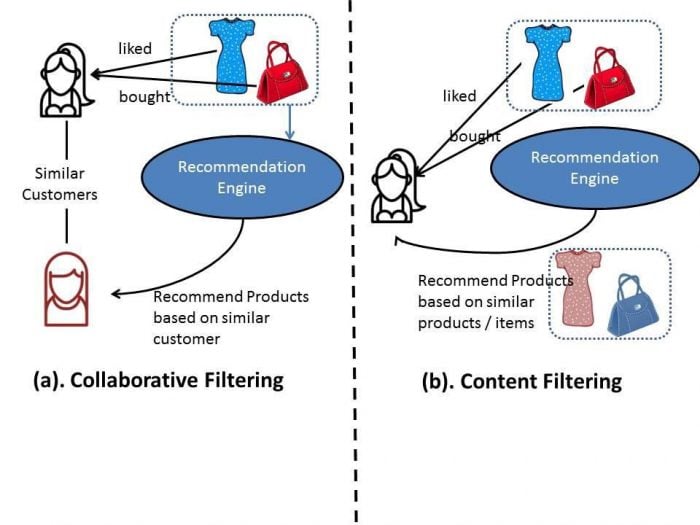When we go shopping, our choices are largely influenced by those of our friends. In other words, we follow recommendations. In the digital age, every online store uses a recommendation engine for the same.
In a nutshell, a recommendation engine is a data filtering tool that utilizes data and algorithms to fetch the user relevant products. In other words, you get what you ask for and products that are similar to it.
If set up correctly, recommendation engines can significantly help you boost your Click-through-rates (CTR), revenue, conversion rate, and so forth. In fact, close to 35% of Amazon’s revenue comes from recommendation engines.
What Is A Recommendation Engine?

Source: Medium
A recommendation engine or system is, essentially, an information filtering system. It uploads information that is specifically tailored to a user’s preferences, history, and interests. In other words, it can predict the user’s product preferences based on their data. This is done through Artificial Intelligence (AI).
Considering the importance and popularity of recommendation systems, it is not surprising that we have many AI development companies or AI solution providers to develop the same.
How Do Recommendation Engines Work?
Recommendation engines typically go through four phases as they process data namely,
– Collection
– Storing
– Analyzing
– Filtering
1. Collection
As you may have expected, collecting or gathering data is the first step to setting up a recommendation engine. This data may be explicit or implicit. Explicit data refers to data that users input, like comments, products, ratings, etc.
Implicit data, however, refer to details like cart reviews, page views, history, return history, and so forth.
Since you can track the user’s activities on your site, collecting behavior data is a breeze. It is also easy because you do not need to get the user to take any action. On the other hand, data analysis is challenging considering the number of logs you need to filter out.
If you have a large sample size of users, you will find that they have a wide range of likes and dislikes, due to which their data sets become distinct. The engine gets smarter with its recommendations as you feed it with more data.
2. Storing
As mentioned, the more data you feed your recommendation engines, the better the recommendations will be. It is likely that your recommendation engine can become a big data project.
As far as storage goes, the type of data you feed your algorithms will determine the storage type you ought to use. You can choose from a variety of storage options, including a standard SQL database, a NoSQL database, object storage, and so forth.
Other factors that come into play while choosing the right storage type are,
– Ease of implementation
– Portability
– Data capacity that the storage can manage
– Whether or not you are capturing user input behavior
– Integration with the rest of the environment
3. Analyzing
In order to find items that have similar user engagement data, you need to filter it through a variety of analysis methods. Here are a few analysis methods:
Real-time Systems
These systems process data as it is created. They generally make use of tools that process and analyze a series of events. If you want to provide in-the-moment recommendations, you need real-time systems in place.
Batch Analysis
Batch analysis refers to processing data periodically. In other words, you need enough data to be created before the analysis can yield real results. Daily sales volume is one such parameter.
Near-Real-time Analysis
This type of analysis enables you to capture data quickly. You may refresh analytics every few minutes to capture the latest details. This system is perfect to provide recommendations during a browsing session.
4. Filtering
The final step is filtering out relevant data for user recommendations, for which you need to use one of the following algorithms.
Content-based: This algorithm shows another product that has similar characteristics to the one the user likes.
Cluster: This refers to showing recommended products as a cluster, allowing the user to check them out.
Collaborative: This method involves collecting and analyzing data on user behavior, activities, and preferences, and predicting what they will like based on similar data that they retrieve from other users.
The Benefits Of Recommendation Engines
If you are still not sold on getting an AI solution development company to develop a recommendation engine, here are a few key benefits of recommendation engines you should know about:
Personalization
Recommendations are useful because they are personal. This is exactly why we ask our friends and family for recommendations. They are personal to our needs and preferences. You may use the data you retrieve to improve your services and ensure the user gets what they want.
Revenue
This one is obvious. Recommendation engines boost CTR, conversion rates, and your overall revenue. Amazon and Netflix generate a large chunk of their revenue from recommendation engines.
Customer Satisfaction
If customers get what they are looking for, they are more likely to revisit your site, and look for further recommendations, either for the same product or a different one. In other words, the more accurate your recommendations, the higher your chances of retaining your customer.
Wrapping Up
Are you looking forward to incorporating the application of AI recommendation engine in your app? Quytech is a leading AI development company that can help you with amazing AI solutions tailored to your business needs. Get in touch today!



